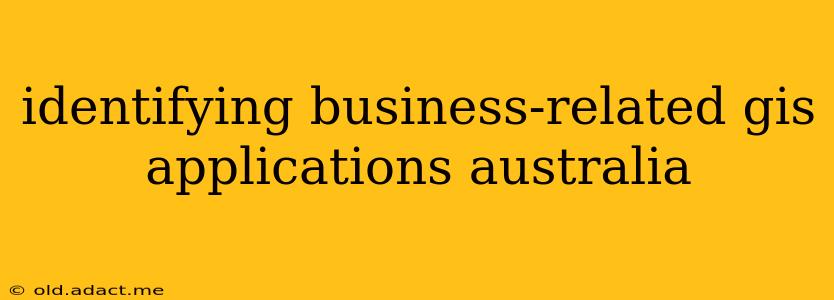Australia, with its vast and diverse landscape, presents unique challenges and opportunities for businesses across various sectors. Geographic Information Systems (GIS) technology plays a crucial role in addressing these challenges and capitalizing on opportunities, offering powerful tools for data analysis, visualization, and decision-making. This article explores the key business-related GIS applications prevalent in Australia.
What are the most common uses of GIS in Australian businesses?
GIS applications in Australian businesses span a wide range of industries. Some of the most common uses include:
-
Real Estate & Property: GIS is extensively used for property valuation, site selection, market analysis, and managing large property portfolios. Australian real estate companies leverage GIS to visualize property locations, analyze surrounding amenities, and identify potential investment opportunities. This includes assessing proximity to transport, schools, and other key factors influencing property values.
-
Utilities & Infrastructure: Managing Australia's extensive infrastructure networks (electricity, gas, water, telecommunications) relies heavily on GIS. Companies use GIS for asset management, network planning, maintenance scheduling, and emergency response. Visualizing underground utilities prevents costly damage during construction projects, for example.
-
Agriculture & Farming: Precision agriculture is booming in Australia. Farmers utilize GIS to optimize irrigation, manage crop yields, monitor soil conditions, and plan field operations. This data-driven approach leads to improved efficiency and profitability.
-
Mining & Resources: Australia's mining sector is a significant contributor to its economy. GIS plays a vital role in exploration, mine planning, environmental monitoring, and mine safety. Visualizing geological data and optimizing extraction processes are crucial applications.
-
Logistics & Transportation: Efficient logistics are critical in a country as geographically spread out as Australia. Businesses use GIS for route optimization, fleet management, delivery scheduling, and warehouse location planning. Minimizing transportation costs and maximizing delivery efficiency are key benefits.
-
Retail & Marketing: Understanding customer demographics and location is crucial for retail businesses. GIS aids in site selection for new stores, targeted marketing campaigns, and supply chain management, ensuring optimal placement and inventory control.
-
Tourism & Recreation: Australia’s tourism industry benefits significantly from GIS. Tourism operators use GIS to create interactive maps, plan tours, manage bookings, and analyze visitor patterns. This facilitates better service provision and improved customer experiences.
-
Environmental Management & Conservation: Australia's diverse ecosystems require careful management. GIS is used for environmental monitoring, biodiversity assessment, bushfire risk management, and conservation planning. This enables effective resource allocation and environmental protection.
What are some examples of specific GIS applications used in Australian businesses?
Many specific software solutions and applications are used within these broader categories. For instance, Esri ArcGIS is a popular choice for many, providing a comprehensive suite of tools. Other specialized software caters to specific industry needs, integrating with existing business systems. The exact application varies depending on the specific business and its requirements.
How does GIS help Australian businesses improve their efficiency?
GIS enhances efficiency in numerous ways:
- Improved Decision Making: Data visualization and spatial analysis empower better informed decisions based on accurate, location-specific data.
- Reduced Costs: Optimizing routes, scheduling, and resource allocation leads to significant cost savings across many sectors.
- Enhanced Productivity: Streamlined workflows and efficient task management improve team productivity and overall output.
- Better Risk Management: Identifying and mitigating risks through proactive spatial analysis helps businesses avoid costly problems.
- Improved Customer Service: Providing better services through optimized location strategies enhances customer satisfaction.
What are the key benefits of using GIS in Australian businesses?
The benefits extend beyond efficiency, encompassing:
- Competitive Advantage: Businesses leveraging GIS gain a competitive edge by utilizing data-driven insights.
- Innovation & Growth: New possibilities and solutions emerge through exploring spatial data and integrating it into business processes.
- Sustainability: GIS supports sustainable practices in many sectors, from optimizing resource use to managing environmental impact.
- Improved Communication: Visualizing data simplifies complex information, fostering clearer communication within teams and with stakeholders.
What are the challenges of implementing GIS in Australian businesses?
While the benefits are numerous, some challenges exist:
- Data Acquisition & Integration: Collecting and integrating data from various sources can be complex and time-consuming.
- Skills & Training: Adequate training for staff is needed to effectively use GIS software and interpret spatial data.
- Cost of Implementation: The initial investment in software, hardware, and training can be significant.
In conclusion, GIS applications in Australia are diverse and far-reaching, offering significant potential for business growth, efficiency, and improved decision-making across numerous sectors. Overcoming the challenges associated with implementation unlocks the powerful capabilities of this technology, providing a competitive edge in today's dynamic business environment.
